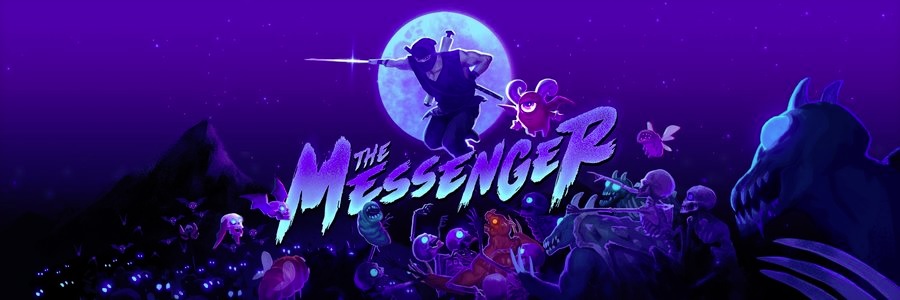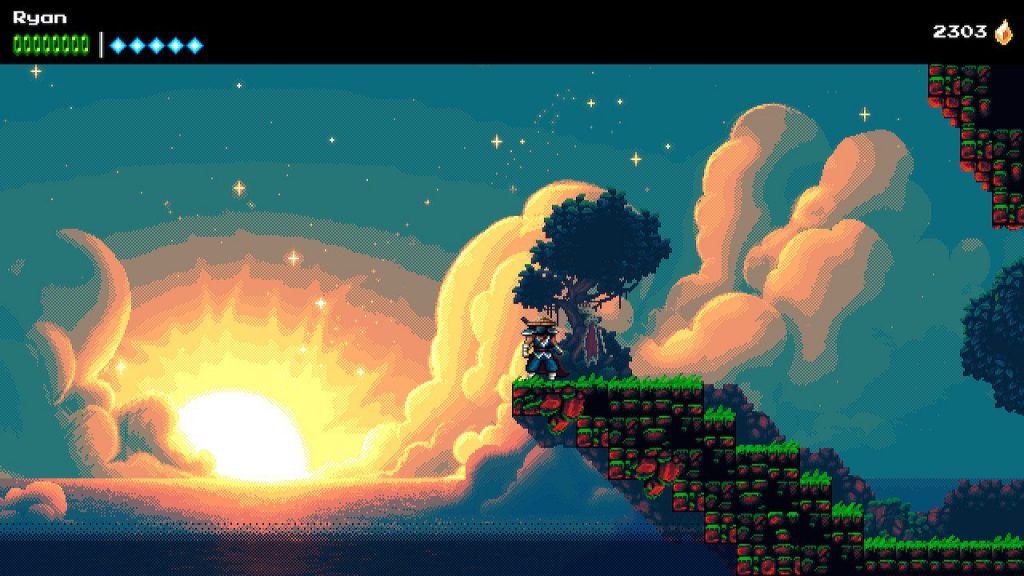The Messenger opens with your unnamed ninja character being given a scroll by a mysterious hero of legend. Your goal from that point on is to trek across the world and deliver said scroll to a group of monks at the top of the highest mountain peak, thus fulfilling an age-old prophecy and ostensibly pushing back the invading forces of Hell.
The reveal of what is contained on the scroll is hilarious.
And that’s the kind of game The Messenger is. It’s a 2D action platformer that stars a ninja out to stop the destruction of his world by demons, but also it takes every opportunity to joke around and keep the adventure a little more light-hearted. This retro-styled throwback game takes plenty of inspiration from games like Ninja Gaiden and Super Metroid and even takes a few cues from the original Teenage Mutant Ninja Turtles on the NES. While I’m sure it’s only coincidence, it also feels and plays remarkably similarly to Ninja Striker on 3DS. That’s a compliment, too, because I very much adore Ninja Striker.
But back to the beginning! The Messenger is your traditional level-based action game. You progress from left to right, all the while slashing monsters and picking up the “time shards” that function as currency. What makes this game’s ninja unique is his fancy “cloudstepping” technique. This is not your standard double-jump, but rather gives you an extra jump every time you slash a lamp, enemy, or projectile. It’s a little tricky to get the hang of, but effectively gives you unlimited jumps as long as there’s something around to slice.
During his travels, the ninja will gain a variety of equipment that allows for an even greater freedom of movement. The climbing claws, which let him cling to and scale walls. The wingsuit that lets him glide gracefully through the air. Most importantly, the rope dart, which functions as a (straight-forward only) grappling hook that lets you grapple to walls, enemies and objects. Once you’ve acquired an mastered all of these abilities, you’re capable of clearing entire screens without touching the ground. And that’s one of the things I love most about The Messenger: it really makes you feel like a badass ninja.
On top of these mandatory pieces of gear, there’s also a mysterious shop that you can visit whenever you find a portal. The shopkeeper is a sassy fellow who is no stranger to fourth-wall breaking or hassling our hero. He also has a new story to tell on every stage, many of which he urges you to contemplate on and try to discern their meanings. But what he’s really there for is to sell you other upgrades. Things like extending your life bar, decreasing how much damage you take, or the ability to use magical shurikens that function as your only ranged attack. These are all practical upgrades, but are completely skippable if you feel like you need to challenge yourself.
And speaking of challenge, oh boy, does The Messenger ever deliver on that front. While the game starts out fairly easy -perhaps even too easy- there’s a noticeable shift around level three or four where training wheels pop off. You’re no longer clearing stages without dying. Heck, you’re not even making it through most screens on your first try. It quickly becomes fairly difficult, and that only continues to intensify throughout the rest of the game. Luckily, despite looking like an NES game, there are no lives, and checkpoints are scattered fairly liberally throughout the world.
However! While the game has plenty of anti-frustration features, that’s not to say that there is no penalty for dying. Enter Quarble, a little demon-guy who serves as an explanation as to why you can keep coming back to life. His job is to revive you whenever you get killed or fall in a bottomless pit. This comes at a cost: Quarble will absorb the next so many time shards that you collect. I don’t know the exact number, but it’s like 30 at most. So while it puts the brakes on your earnings for a while, you never actually lose anything for dying. Also, Quarble gives you a cute little blurb after each death (some of which are pretty funny), so one might even say that you make a very modest gain from dying.
Okay, so now that all the basics are out of the way, it’s SPOILER TIME. Sabotage Studio had been none too shy about showing off how one of the big features of The Messenger was that you travel forward in time, which changes the graphics and music from an 8-bit style to a 16-bit style. This alone is a very cool feature, but it doesn’t come up until what feels like very late in the game. Like, I thought that I was heading into the endgame once the flip happened. So I wasn’t sure if it was just a one-time dealie for the finale or what.
But then you beat what your gamer-sense tells you is the penultimate boss, and everything changes. You’re no longer in a level-based action platformer, but rather a full-on metroidvania. There’s a hub with teleporters, you get a big ol’ map, secrets are everywhere. All the things you know and love are here, and it effectively serves to double (or more) the length of the game. Yes, you’re retreading all the levels you already went through. But there are places you couldn’t reach before! And they have huge new portions that open up when you switch to the future! And there are also entirely new levels!
In retrospect, I should have seen it coming. There are green jewels in each stage that unlock a secret upgrade. I was only finding one per level, and I was searching very thoroughly. But there were like 46 total to find, so either there were way more stages than I was expecting, or something else had to give. It was the something else!
So now you have an expanded world and unlimited access to it, and your quest is to search for a handful of magical doodads. It’s actually very Metroid Prime. Except less tedious because there’s tons of new ground to cover and you’re still acquiring new equipment and upgrades. Plus even the places you’ve been already are different when you’re in 16-bit mode. It’s not just a simple “you can break these walls now, have at ‘er” kind of thing. This is the game letting you off the leash and fully opening up, not just making you backtrack everywhere. I’d say it’s more like the upside-down castle in Symphony of the Night, if I had to make a comparison to something.
There isn’t a lot of room then, for debate about whether or not there are lots of cool things going on in The Messenger. There absolutely are! But there are lots of games with plenty of great ideas that end up falling flat upon execution. I’d like to go on record and say that The Messenger is absolutely not one of those games. First and foremost, it feels perfect. Like, there aren’t many non-Nintendo games that have such perfectly precise controls, but this one absolutely nails it. The ninja guy moves exactly the way that I feel he should, and just running and jumping feels great. Nevermind once you get all the advanced moves and you can dance through the sky like, well, a ninja. There’s no slipperiness, he’s not too floaty or too heavy. The controls are so wonderfully tight, it feels like a dream.
Equally important is that The Messenger looks and sounds amazing. Like, I get that the whole retro-pixel look is very subjective and isn’t going to wow a certain subset of game enthusiasts, but I love it. The visuals are so detailed and vivid, plus every single sprite and background in the game was drawn in two distinct styles, which is no simple feat! Every stage has a unique and distinct aesthetic. Though a lot of them play fairly close to the established tropes, I feel like they really twist those tropes enough to keep them fresh. And then there’s the music. Oh my lord, the music! Composed by a man of some renown that I’ve never heard of, the tunes in The Messenger are phenomenal. Like, I am constantly singing along to them because they’re so damned catchy. And again, there’s two versions of every song! It’s incredible! The one and only downside is that the 16-bit versions go with a more Genesis-styled soundscape, which is an odd choice to make. Like, has this “Rainbowdragoneyes” fellow not heard of the SNES and its amazing sound chip? Well, whatever. It’s the artist’s choice and I respect that. The point is, the entire OST is fire and I’m buying it as soon as I’m done writing this review.
When it comes down to what kind of dollar-to-hour ratio you’re getting with The Messenger, I’d say it’s just a little bit past the sweet spot. Not to the extent of Hollow Knight (which is a very long metroidvania) or anything, but it took me thirteen and a half hours to finish The Messenger. Of course, I also went for the full 100%, so it could likely be finished in considerably less time. It was rewarding though, as getting all the collectibles made sure that I saw every challenge the game had to offer, and many of the most difficult parts were optional. None felt cheap or too mean, they were just right, and made me feel really awesome when I finally passed them. I also racked up somewhere above 200 deaths over the course of my playthrough, which is astonishingly less than I would have guessed.
The final word on this one is that yes, it is an absolute gem and should be played by anyone with any sort of appreciation for solid 2D action games. It is immaculately designed and flows ever so beautifully. I just really can’t get over how much I enjoyed The Messenger, and it has rightfully earned a place in the pantheon of my favourite games of all time, right next to gems like Mega Man X and Shovel Knight. If it weren’t for the fact that a new Super Smash Bros game is releasing this year, I would say that The Messenger could very likely take the title of my 2018 Game of the Year. Yep. I like it that much. A+ job on this one, Sabotage Studio. I eagerly anticipate your next video game.


